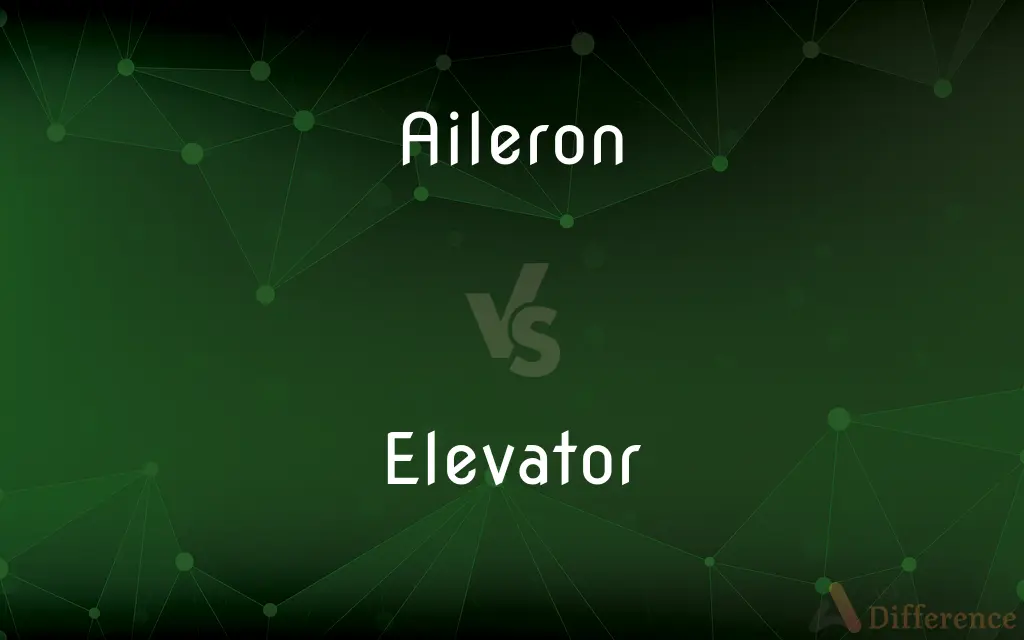Aileron vs. Elevator — What's the Difference?
By Fiza Rafique & Urooj Arif — Updated on May 2, 2024
Ailerons control aircraft roll by tilting wings side-to-side, whereas elevators manage pitch, tilting the nose up or down.

Difference Between Aileron and Elevator
Table of Contents
ADVERTISEMENT
Key Differences
Ailerons are hinged on the wings of an aircraft and are pivotal in controlling the roll, which is the side-to-side tilting of the aircraft during maneuvers. Whereas, elevators are attached to the tailplane and are crucial for controlling the pitch, adjusting the aircraft’s nose up or down.
Ailerons work by moving in opposite directions on each wing; when one goes up, the other goes down, creating differential lift and causing the aircraft to roll. On the other hand, elevators move in unison to either increase or decrease the lift on the tail, tilting the nose respectively down or up.
Pilots use ailerons primarily to initiate turns or to stabilize the aircraft in crosswinds. Whereas, elevators are used to adjust the angle of attack of the wings, crucial for climbing, descending, or maintaining level flight.
During a standard turn, ailerons and elevators are used together; ailerons to roll the plane into the turn and elevators to adjust the pitch to maintain altitude. On the other hand, elevators can also be used independently for pitch adjustments without changing the roll angle.
While ailerons are usually located on the trailing edge of each wing, elevators are positioned on the horizontal part of the tailplane, showing the spatial differentiation in their placement and function.
ADVERTISEMENT
Comparison Chart
Location
Wings
Tailplane
Function
Control roll (side-to-side tilt)
Control pitch (upward or downward tilt)
Movement
Opposite on each wing (one up, one down)
Uniform (both parts move in the same direction)
Usage in Flight
Primarily for turning and stabilizing in crosswinds
For climbing, descending, and maintaining level
Effect on Aircraft
Causes aircraft to roll around its longitudinal axis
Causes aircraft to pitch around its lateral axis
Compare with Definitions
Aileron
Used to induce roll by creating differential lift on the wings.
Moving the stick left, the right aileron lowered, and the aircraft began to roll.
Elevator
Controlled via the forward and backward movement of the control yoke.
He pushed forward on the yoke, lowering the elevators for a descent.
Aileron
A hinged flight control surface on the wing of an aircraft.
The pilot adjusted the ailerons to roll the plane to the left.
Elevator
A movable control surface located on the horizontal stabilizer of an aircraft.
The pilot pulled back on the control yoke, raising the elevators to climb.
Aileron
Manipulated via the control stick in the cockpit.
With a slight movement of the control stick, he activated the ailerons.
Elevator
Moves synchronously for coordinated pitch control.
During the approach, both elevators moved upwards to reduce speed.
Aileron
Operates opposite to each other on each wing.
As the left aileron rises, the right aileron descends.
Elevator
Controls the aircraft’s pitch to point the nose up or down.
Lowering the elevators, the aircraft began a gentle descent.
Aileron
Integral for maneuvering and stability in the air.
The ailerons responded crisply, stabilizing the aircraft amidst turbulence.
Elevator
Essential for altitude control during flight.
Adjusting the elevators helped maintain a steady altitude over the mountains.
Aileron
An aileron (French for "little wing" or "fin") is a hinged flight control surface usually forming part of the trailing edge of each wing of a fixed-wing aircraft. Ailerons are used in pairs to control the aircraft in roll (or movement around the aircraft's longitudinal axis), which normally results in a change in flight path due to the tilting of the lift vector.
Elevator
An elevator (North American English) or lift (Commonwealth English) is a type of cable-assisted, hydraulic cylinder-assisted, or roller-track assisted machine that vertically transports people or freight between floors, levels, or decks of a building, vessel, or other structure. They are typically powered by electric motors that drive traction cables and counterweight systems such as a hoist, although some pump hydraulic fluid to raise a cylindrical piston like a jack.
Aileron
Either of two movable flaps on the wings of an airplane that can be used to control the plane's rolling and banking movements.
Elevator
A platform or an enclosure raised and lowered in a vertical shaft to transport people or freight.
Aileron
The hinged part on the trailing edge of an airplane wing, used to control longitudinal turns.
Elevator
The enclosure or platform with its operating equipment, motor, cables, and accessories.
Aileron
(architecture) A half gable, as at the end of a penthouse or of the aisle of a church.
Elevator
A movable control surface, usually attached to the horizontal stabilizer of an aircraft, that is used to produce motion up or down.
Aileron
A half gable, as at the end of a penthouse or of the aisle of a church.
Elevator
A mechanism, often with buckets or scoops attached to a conveyor, used for hoisting materials.
Aileron
A small plane or surface capable of being manipulated by the pilot of a flying machine to control lateral balance; a hinged wing tip; a lateral stabilizing or balancing plane.
Elevator
See grain elevator.
Aileron
An airfoil that controls lateral motion
Elevator
Anything that raises or uplifts.
Elevator
A permanent construction with a built-in platform or cab that can be raised and lowered, used to transport people and goods, as between different floors of a building.
Elevator
A silo used for storing wheat, corn or other grain (grain elevator).
Elevator
(aeronautics) A control surface of an aircraft responsible for controlling the pitching motion of the machine.
Elevator
A dental instrument used to pry up ("elevate") teeth in difficult extractions, or depressed portions of bone.
Elevator
(anatomy) Any muscle that serves to raise a part of the body, such as the leg or the eye.
Elevator
A type of shoe having an insert lift to make the wearer appear taller.
Elevator
One who, or that which, raises or lifts up anything.
Elevator
A mechanical contrivance, usually an endless belt or chain with a series of scoops or buckets, for transferring grain to an upper loft for storage.
Elevator
A cage or platform (called an elevator car) and the hoisting machinery in a hotel, warehouse, mine, etc., for conveying persons, goods, etc., to or from different floors or levels; - called in England a lift; the cage or platform itself.
Elevator
A building for elevating, storing, and discharging, grain.
Elevator
A muscle which serves to raise a part of the body, as the leg or the eye.
Elevator
An instrument for raising a depressed portion of a bone.
Elevator
A movable plane or group of planes used to control the altitude or fore-and-aft poise or inclination of an airship or flying machine.
Elevator
Lifting device consisting of a platform or cage that is raised and lowered mechanically in a vertical shaft in order to move people from one floor to another in a building
Elevator
The airfoil on the tailplane of an aircraft that makes it ascend or descend
Common Curiosities
Where are ailerons located on an aircraft?
Ailerons are located on the trailing edges of the wings.
How do elevators affect an aircraft’s movement?
Elevators control the pitch of the aircraft, tilting the nose up or down.
Can elevators and ailerons be used simultaneously?
Yes, they often work together during maneuvers like turns.
How do pilots control ailerons?
Pilots manipulate ailerons via the control stick in the cockpit.
What is the primary function of an aileron?
Ailerons are used to control the roll of an aircraft.
What is differential lift in context with ailerons?
Differential lift refers to the varying lift generated by the opposing movements of ailerons on each wing.
What is the effect of raising elevators during flight?
Raising elevators causes the aircraft to pitch up, increasing altitude.
What happens when the elevators move in unison?
When elevators move in unison, they uniformly change the pitch of the aircraft.
What role do elevators play in an aircraft’s descent?
Elevators are lowered to tilt the nose down, facilitating descent.
How do ailerons stabilize the aircraft in crosswinds?
Ailerons can be adjusted to counteract the rolling effect induced by crosswinds.
How does lowering the ailerons affect aircraft motion?
Lowering one aileron while raising the other causes the aircraft to roll in the direction of the lowered aileron.
Is there a safety mechanism if one of the elevators fails?
Most modern aircraft are designed with redundant systems to ensure control even if one elevator fails.
Are ailerons and elevators visible from outside the aircraft?
Yes, both are external and clearly visible components of an aircraft.
What type of control input is used for elevators?
Elevators are controlled by pushing or pulling the control yoke.
Can faulty ailerons compromise an aircraft’s stability?
Yes, malfunctioning ailerons can significantly affect an aircraft’s ability to roll effectively.
Share Your Discovery

Previous Comparison
Temerity vs. Timorousness
Next Comparison
Futsal vs. HandballAuthor Spotlight
Written by
Fiza RafiqueFiza Rafique is a skilled content writer at AskDifference.com, where she meticulously refines and enhances written pieces. Drawing from her vast editorial expertise, Fiza ensures clarity, accuracy, and precision in every article. Passionate about language, she continually seeks to elevate the quality of content for readers worldwide.
Co-written by
Urooj ArifUrooj is a skilled content writer at Ask Difference, known for her exceptional ability to simplify complex topics into engaging and informative content. With a passion for research and a flair for clear, concise writing, she consistently delivers articles that resonate with our diverse audience.
















































